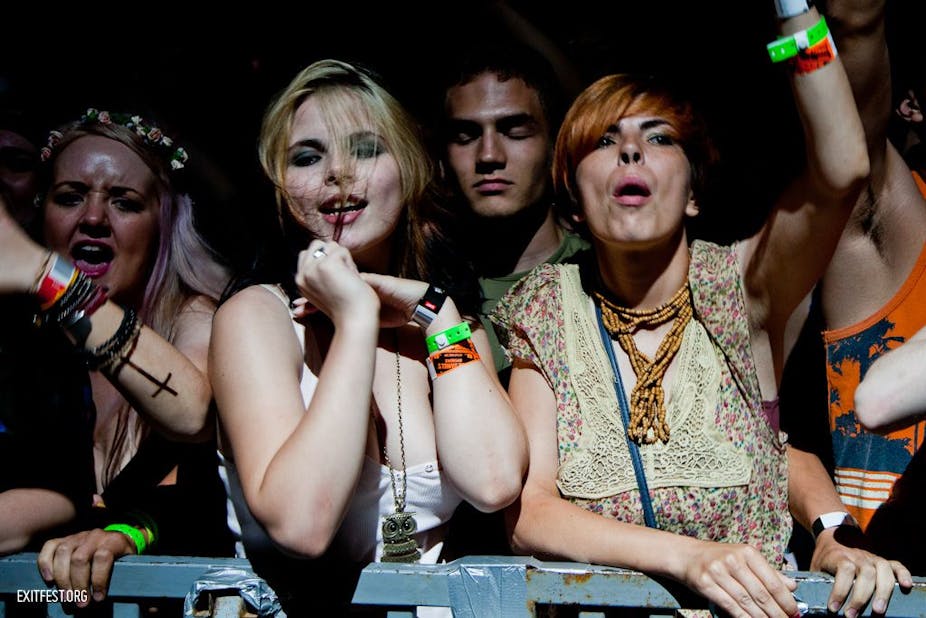You have probably felt the power of music to lift you out of yourself. Perhaps you were in a magnificent cathedral, listening to a choral mass. Maybe you were at a music festival where the music made you forget the bad weather and appalling toilet facilities. Whatever the setting, music can lead us into a shared experience of ecstasy – a word which literally means “to stand outside oneself”.
For my recent book Exaltation I examined two different musical “spaces” in which people experience ecstasy catalysed by music. The first was a Pentecostal congregation in suburban Perth; the second was the West Coast Blues ‘n’ Roots Festival.
Music as a catalyst for ecstasy
At first, these settings may appear to have little in common. Yet, in both, music is used to create a discrete space for ecstatic experience. At the Pentecostal church, regular attendees are greeted with a sound designed to help them “break free” from the world outside the church meeting.
The driving rhythms lift congregants up and then ebb – allowing them to soar in “free worship”. In this space, participants believe they encounter the divine.

Similarly, at the music festival, performers such as John Butler Trio, Wolfmother, and Xavier Rudd lead participants on an odyssey. They begin with their less familiar catalogue and move inevitably toward the well-known songs that elicit maximum audience participation. Euphoria mounts and barriers dissolve as people dance and sing together, forming temporal, liminal communities.
Also, within both of these spaces people engage in behaviour that they would be unlikely to indulge in otherwise. At the music festival I witnessed a man standing (yes, standing) on another man’s shoulders, strangers embracing and women flashing their breasts while perched on the shoulders of friends. One of the festival attendees I interviewed saw it this way:
There is a very real loss of self consciousness … I don’t think it’s very often in our daily lives that we share that with very many people together, and to all have those barriers down together is a special thing.

At the church I heard people utter streams of a strange sounding language (also known as “speaking in tongues”), and I saw people standing with outstretched arms and closed eyes lifted to heaven, totally lost in a private – yet shared – experience. One of the members of the church described this “worship” experience:
The songs that they played were beautiful, they were prophetic, sensitive, they would build them up and then they would ebb and flow … To the point where on Sunday night it felt like God was in the tent … everybody was on the floor either weeping or crying or out to the power of God.
Of course, these spaces are different in important ways, too. The festival stands in the tradition of the medieval carnival. This was a time before the asceticism of Lent for the celebration of the carnal at the expense of the sacred. The open enjoyment of alcohol and marijuana undoubtedly contributed to the feelings of warmth and togetherness shared in the festival mosh pit.
In contrast, ecstasy in a church is connected to the Holy Other, and is a sanitised phenomenon, focused on the spirit rather than the body. Any sexuality is latent, not openly expressed.
Beyond the limit?

Yet these spaces are united in a common use of music as a catalyst of ecstasy. If music can transport people outside of themselves, where does it take them? And who do they find there? I discerned two dimensions to the connections people experience in these moments of self-transcendence.
First, the power of music to catalyse ecstasy can be thought of as a vertical dimension of the musical realm. Religious people may understand this as an encounter with the divine.
Another interpretation involves what philosopher Michel Foucault calls a “limit experience” – a transcending of the boundaries of the “self” – not into a divine presence, but rather a space of endless possibilities.
Second, I observed a horizontal dimension in these ecstatic spaces. In being lifted out of themselves, participants can be joined to others. Individuals in these group experiences have less self-consciousness and inhibition, and may experience a profound sense of unity where social boundaries surrounding personal space are lowered.
Building bridges

In an (arguably) post-secular society, focusing on what these experiences have in common may help us to build bridges and connect to what unites us.
Those applying a spiritual interpretation to musically-catalysed ecstasy could remain open to an alternative – those who may not share their faith nevertheless do share their experience.
Similarly, those who enjoy their ecstasy secular could embrace the spiritual understanding others may hold of what lies beyond the limit.
Such an approach emphasises what is common to these experiences – our shared humanity, which can draw us together.
The author would like to acknowledge the contribution of Jennifer Carson (BSc, PhD), owner of Ghost Media, to this article.

